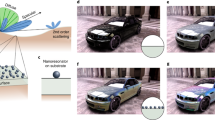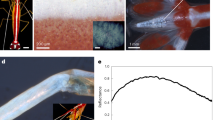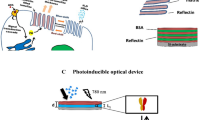Abstract
In this paper, we describe a novel concept for creating multicolor light reflectors by mimicking the surface structures of tiger beetle shells. We prepared dimpled and multilayered films containing thin black layers, which had multi-angle reflectivity, by embossing a silicone microlens array. The surface structuring caused the reflected light to be scattered at multiple angles and thus visible at different viewing angles. This scattering system increases the visibility of the biological surface colors and blends the reflected colors of tiger beetles. These results demonstrate that combining multilayered structures with surface structuring produces unique optical properties.
Similar content being viewed by others
Introduction
The structural colors of insects are of great interest in both biology and material science. It is crucial for biologists to understand the relationship between the color of organisms and their environment owing to the importance of this relationship to their survival and reproduction.1 The structural colors of living things have also inspired material scientists to develop new photonic crystals and other optical materials. Several approaches have been used to understand and mimic the hierarchical structures that produce biological structural colors, especially in insects. Yoshioka and Kinoshita2 have reported that the structural colors of Morpho butterflies are generated by nanostructures in the wing scales. Shopsowitz et al.3 have prepared free-standing chiral nematic films by mimicking the cholesteric liquid crystals found in insect elytra. Baumbergand colleagues have also reported on the unique polarization properties of micro dimple structures on the surface of butterfly wing scales and have created artificial materials to demonstrate the polarization phenomena.4 Srinivasarao and colleagues have also reported on the preparation of a similar surface structure using self-organized porous polymer templates.5 These studies suggest that nano- and microscale structures strongly affect the coloring of insects.
Jewel beetles, also known as tiger beetles, exhibit beautiful iridescent structural colors6 that are thought to arise from several alternating electron-lucent and electron-dense layers on the epicuticle of the elytra. However, it is not clear as to why such a strong reflection is generated from a small number of multilayers consisting of organic biological molecules with small differences in their refractive indices. The same phenomenon has been reported in the Japanese jewel beetle.7 Schultz and colleagues have reported that tiger beetles have a multilayered structure that generates structural colors.8 They estimated that the refractive index of the electron-dense layer was approximately 2.0 and suggested that this layer consists of melanin dyes. Because melanin dyes should have high refractive indices similar to other dye molecules, the reflectance at the interface between the melanin layer and the cuticle layer, which has a considerably lower refractive index than the melanin dyes, should be enhanced. We have previously reported that thin black layers in multilayered sub-wavelength-scale structures fabricated from poly(butadiene) (PB) produced strong reflection colors, which depended on the thicknesses of the layers, and functioned as efficient one-dimensional (1D) photonic crystals.9 The photo-cross-linking of PB also allows one-dimensional photonic crystals to be patterned.
Although tiger beetles are usually beautiful iridescent greens, blues and reds, cryptic tiger beetles have a dull-brown elytra. Schultz and Bernard have also reported that there are green-rimmed blue spots, tens of micrometers in diameter, that are distributed in a red matrix on the elytra of the cryptic tiger beetle. They suggested that the micrometer-scale dimple structure on the surface of the elytra has an important role in this color mixing;10 however, the mechanism of these color-mixing properties is not well understood. In this paper, we report on the multilayered structures and surface structures of the elytra of tiger beetles. We also prepared surface dimple structures on one-dimensional photonic crystals with thin black layers to mimic the elytra structures. We found that the angle dependency of the reflection from the multilayered structure was altered by the surface microstructures.
Materials and methods
Characterization of tiger beetles
The tiger beetle, Cicindela sachalinensis, was collected in Nopporo Forest Park, Sapporo, Japan. The specimen was immediately placed in ethanol after it was collected. The surface structure of the elytra was observed under a digital microscope (VHX-900, Keyence, Osaka, Japan) and a field-emission scanning electron microscope (FE-SEM, S-5200, Hitachi, Tokyo, Japan). For the FE-SEM observations, the elytra was cut with a scalpel and coated with Os by discharge sputtering (Sinku Kiko, Saito, Japan).
Preparation of multilayered micro dimple arrays
The multilayered micro dimple array (MLMDA) films were prepared by alternately coating a glass substrate with layers of PB (RB820, JSR, Japan) and Os, which was followed by embossing the multilayered film with a polydimethylsiloxane (PDMS) microlens array (MLA) (Figure 2). The glass substrate was cut into 30 × 30 mm squares, treated with UV-O3 (Iwasaki Denki, Japan), and then washed with acetone and methanol. A 25- or 40-mg ml−1 toluene (GR/Wako Chemical Inc., Japan) PB solution was spin cast onto the glass substrate at 1000–3000 r.p.m. The specimen was then coated with Os by discharge sputtering for 5 s. Alternating layers of PB and Os were deposited to create multilayered films consisting of 4–6 layers. The preparation of PDMS MLAs has been described in detail elsewhere.11 A honeycomb-patterned porous polystyrene film prepared using the breath figure method was used as a template. A prepolymer consisting of PDMS and a Pt catalyst (Sylpot 184, Dow Corning, Midland, MI, USA) was mixed and cast onto the honeycomb-patterned porous film (φ ∼10 μm). The bubbles were removed in vacuo, and the prepolymer was cured at 70 °C in an electric oven. The honeycomb-patterned template film was removed by immersing it in CHCl3 for 12 h. The multilayered film was placed on a hot stage (RH-600, Japan Hi-Tech, Tokyo, Japan), and then the PDMS MLA was placed on the multilayered film. The MLA structure was embossed onto the multilayered film by heating at 120 °C with a pressure of 0.7 MPa for 15 min. After cooling to room temperature the specimen was removed from the PDMS MLA with tweezers.
Analysis
Photographs of the samples were taken with a digital camera (EOS-7D, Canon, Tokyo, Japan). Surface and cross-sectional structures were observed with an FE-SEM (S-5200, Hitachi). All the FE-SEM specimens were coated with Os by discharge sputtering. The surface structures of the MLMDA films were also observed using an atomic force microscope (AFM; SPA-400, SII, Chiba, Japan). Diffuse reflection spectroscopy was performed using a V-670 spectrophotometer (Jasco, Tokyo, Japan) equipped with a diffuse reflection spectroscopy unit.
Results and discussion
Figure 1a shows a photograph of the tiger beetle specimen with brown and white regions on the elytra. Figure 1b shows a close-up optical micrograph of the brown region. There were red, green and blue areas distributed in the brown region, and 10 μm honeycomb-like surface dimples were observed on the surface of the elytra. The SEM and close-up SEM images of the surface dimples revealed that the dimples were uniform in size (Figure 1c) and had a multilayered structure with a thicknesses of ∼200 nm (Figure 1d). These results indicate that a material that mimics the optical properties of tiger beetle elytra should be fabricated with multilayered structures, several hundred nanometers thick, that are patterned with dimple structures tens of micrometers in diameter.
Figure 2a shows a schematic illustration of a MLMDA. Each MLMDA film was prepared by alternately coating the glass substrate with layers of poly(-1,2-butadiene) (PB) and Os followed by embossing the multilayered film with a PDMS MLA. Details of the fabrication process of the MLMDA are described in the experimental section. The cross-sectional SEM images and photographs of the multilayered films are shown in Figure 2b. The multilayered structures of the films were clearly visible, and the thickness of the PB layers increased as the spinning rate decreased. As the thickness of the PB layers increased, the colors of the films changed from purple to green to red.
Figure 3 shows the diffuse reflection spectra of the multilayered films (solid lines). The spectrum of the purple film prepared by spin coating at 3000 r.p.m. had a clear reflection peak at 415 nm. As the spinning rate was decreased to 2000 and 1000 r.p.m., the peaks were red-shifted to 505 and 550 nm, respectively, and the thickness of the PB layers increased. These results are consistent with previously reported experimental results and theoretical calculations.9
After embossing the PDMS MLAs onto the multilayered films, the surface structure of the MLMDA films was inspected by optical microscopy, atomic force microscope and FE-SEM, as shown in Figures 4a–c, respectively. The optical micrograph showed the hexagonally arranged dimple structure, whereas the atomic force microscope image revealed that the dimples had an average depth of 300 nm and a rim-like outline. During the embossing process, the molten PB flowed from the center to the edge of the dimples, subsequently forming the rims around the dimple as the film cooled to room temperature. The cross-sectional FE-SEM image of the MLMDA film clearly showed the presence of the dimple arrays and the multilayered structure remained beneath the surface that contained the dimple array layers.
A photograph of the purple, green and red MLMDA films is shown in Figure 4d. The diffuse reflection spectra of the MLMDA films are shown in Figure 3 (dashed lines). The reflection peaks were red-shifted from the original multilayered films, and the reflection intensities increased. This increase in the reflection intensity is caused by the scattering of light at the structured surfaces. Because the dimple-structured surfaces have a larger surface area than the flat surface, the interfacial area between the air and the surface of the material is greater. Moreover, the curved interface scattered the incident light at many angles. Therefore, the intensities of the total reflection of the MLMDA films are considerably higher than that of the flat film.
The angular dependence of the incident light on the reflection of the MLMDA films provided valuable information for understanding this optical property. The surface dimple structures scattered the incident light (irradiated 45° to the sample surface) at many different angles. When the MLMDA film and a flat multilayered film were photographed from normal or shallow angles, the reflection color was only observed for the MLMDA film (Figure 4e). Furthermore, when the films were photographed from the total reflection angle of the flat film, the reflection color was observed for both films. These results indicate that the multi-angle reflection, which creates the observed structural color, was caused by the dimple pattern. With respect to the elytra of tiger beetles, as this multi-angle scattering property is absolutely imperative for possessing color-mixing properties, this result is the first step toward creating a novel type of biomimetic structural coloring. Similar surface structures are also observed on the surfaces of some types of butterflies.4 The simple process of creating multilayered structures with dimpled surfaces provides a novel pathway to understand biological systems.
Conclusion
We prepared dimpled and multilayered films containing thin black layers, which had multi-angle reflectivity, by embossing a PDMS MLA. The surface structuring caused the reflected light to be scattered at multiple angles and thus visible at different viewing angles. These results demonstrate that combining multilayered structures and surface structuring produces unique optical properties.
References
Kinoshita, S. & Yoshioka, S. Structural colors in nature: The role of regularity and irregularity in the structure. Chem. Phys. Chem. 6, 1442 (2005).
Yoshioka, S. & Kinoshita, S. Effect of macroscopic structure in iridescent color of the peacock feathers. Forma 17, 169 (2002).
Shopsowitz, K. E., Stahl, A., Hamad, W. Y. & MacLachlan, M. J. Hard templating of nanocrystalline titanium dioxide with chiral nematic ordering. Angew. Chem. Int. Ed. 51, 6886 (2012).
Kolle, M., Salgard-Cunha, P. M., Scherer, M. R. J., Huang, F., Vukusic, P., Mahajan, S., Baumberg, J. J. & Steiner, U. Mimicking the colourful wing scale structure of the Papilio blumei butterfly. Nat. Nanotech. 5, 511 (2010).
Crne, M., Sharma, V., Blair, J., Park, J. O., Summers, C. J. & Srinivasarao, M. Biomimicry of optical microstructures of Papilio palinurus. EPL 93, 14001 (2011).
Schultz, T. D. & Rankin, M. A. Developmental changes in the interference reflectors and colorations of tiger beetles (Cicindela). J. Exp. Biol. 117, 87 (1985).
Kurachi, M., Takaku, Y., Komiya, Y. & Hariyama, T. The origin of extensive colour polymorphism in Plateumaris sericea (Chrysomelidae, Coleoptera). Naturwissenschaften 89, 295 (2002).
Seago, A. E., Brady, P., Vigneron, J.-P. & Schultz, T. D. Gold bugs and beyond: a review of iridescence and structural colour mechanisms in beetles (Coleoptera). J. R. Soc. Interface 6, S165 (2009).
Yabu, H., Nakanishi, T., Hirai, Y. & Shimomura, M. Black thin layers generate strong structural colors; a biomimetic approach for creating one-dimensional (1D) photonic crystals. J. Mater. Chem. 21, 15154 (2011).
Schultz, T. D. & Bernard, G. D. Pointillistic mixing of interference colours in cryptic tiger beetles. Nature 337, 72 (1989).
Yabu, H. & Shimomura, M. Simple fabrication of micro lens arrays. Langmuir 21, 1709 (2005).
Acknowledgements
H.Y. gratefully acknowledges Emiko Yamazaki of Tohoku University and Yasutaka Matsuo of Hokkaido University for assisting with the SEM observations and visible light spectroscopy, respectively. H.Y. also acknowledges financial support received through a Grant-in-Aid for Priority Areas ‘Metamaterials’ (No. 23109502), and a Grant-in-Aid for Challenging Exploratory Research (No. 23651100), MEXT, Japan.
Author information
Authors and Affiliations
Corresponding author
Rights and permissions
About this article
Cite this article
Yabu, H., Saito, Y. & Shimomura, M. Unique light reflectors that mimic the structural colors of tiger beetles. Polym J 46, 212–215 (2014). https://doi.org/10.1038/pj.2013.90
Received:
Revised:
Accepted:
Published:
Issue Date:
DOI: https://doi.org/10.1038/pj.2013.90
Keywords
This article is cited by
-
Investigating the nanomechanical properties and reversible color change properties of the beetle Dynastes tityus
Journal of Materials Science (2017)







